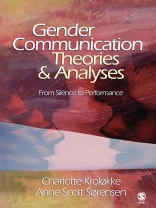Gender Communication Theories and Analyses surveys the field of gender and communication with a particular focus on gender and communication theories and methods. How have theories about gender and communication evolved and been influenced by first-, second-, and third-wave feminisms? And similarly, how have feminist communication scholars been inspired by existing methods and aspired to generate their own? The goal of the text is to help readers develop analytic focus and knowledge about their underlying assumptions that gender communication scholars use in their work.
Features and Benefits:
- Applies theoretical and methodological lenses to contemporary cases, allowing readers to see gender and communcation theory work in action.
- Presents a comprehensive introduction to particular feminist theories and methodologies.
- Provides effective end-of-chapter cases and sample analyses that help readers see the kinds of questions and analyses that a particular theory and method bring into play.
- Discusses contemporary research in gender and communication and expands on future directions for research.
Tabela de Conteúdo
Introduction
Acknowledgments
1. Three Waves of Feminism: From Suffragettes to Grrls
The First Feminist Wave: Votes for Women
The Second Feminist Wave: ‘The Personal Is Political’
The Third Feminist Wave: Transversal Politics
Our Own Situatedness: Transversity
2. Feminist Communication Theories
Structuralism and Feminist Communication Theories
Poststructuralism and Feminist Communication Theories
Conclusion
3. Feminist Communication Methodology
Structuralism and Methodology
Poststructuralism and Methodology
Conclusion
4. Sexist Discourse, Deficit and Dominance
From Deficit to Dominance
Situated Dominances
Case Study: Feminist Conversation Analysis (FCA)
5. Discourses of Difference and Identity
Gender, Discourse, and Articulation
Settings of Difference
Case Study: Feminist Critical Discourse Analysis (FCDA)
6. Gender and Performance
Gender, Performance, and Communication
Situated Performances
Case Study: Feminist Poststructuralist Discourse Analysis (FPDA)
Conclusion
From Silence to Performance
From Conversation Analysis to Poststructuralist Discourse Analysis
Toward Transitivity: What Does the Future Hold?
References
Index
About the Authors
Sobre o autor
Anne Scott Sørensen (Ph.D., University of Southern Denmark; M.A., Aarhus University; B.A., Royal School of Library & Information Science) is Associate Professor and Head of the Center for Cultural Studies at the University of Southern Denmark. She has written extensively on gendered speech communities from the salons in Europe in the 18th – 20th centuries to the online communities of young people in the 21st century. She is Head of the Danish Network for Cultural Studies and a board member of the International Association of Cultural Studies.












